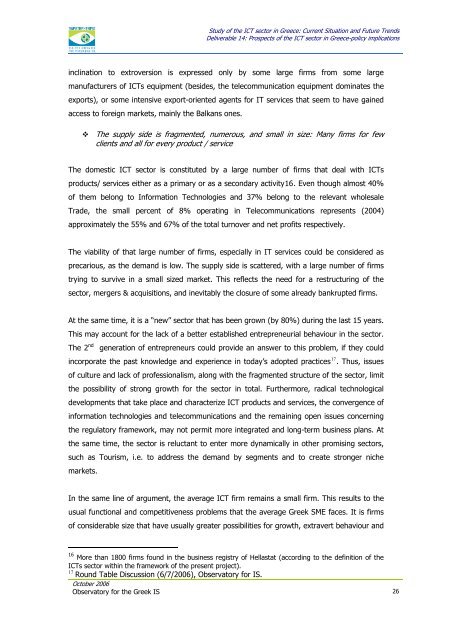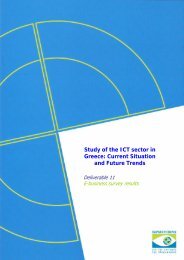Prospects of the ICT sector in Greece
Prospects of the ICT sector in Greece
Prospects of the ICT sector in Greece
- No tags were found...
Create successful ePaper yourself
Turn your PDF publications into a flip-book with our unique Google optimized e-Paper software.
Study <strong>of</strong> <strong>the</strong> <strong>ICT</strong> <strong>sector</strong> <strong>in</strong> <strong>Greece</strong>: Current Situation and Future Trends<br />
Deliverable 14: <strong>Prospects</strong> <strong>of</strong> <strong>the</strong> <strong>ICT</strong> <strong>sector</strong> <strong>in</strong> <strong>Greece</strong>-policy implications<br />
<strong>in</strong>cl<strong>in</strong>ation to extroversion is expressed only by some large firms from some large<br />
manufacturers <strong>of</strong> <strong>ICT</strong>s equipment (besides, <strong>the</strong> telecommunication equipment dom<strong>in</strong>ates <strong>the</strong><br />
exports), or some <strong>in</strong>tensive export-oriented agents for IT services that seem to have ga<strong>in</strong>ed<br />
access to foreign markets, ma<strong>in</strong>ly <strong>the</strong> Balkans ones.<br />
The supply side is fragmented, numerous, and small <strong>in</strong> size: Many firms for few<br />
clients and all for every product / service<br />
The domestic <strong>ICT</strong> <strong>sector</strong> is constituted by a large number <strong>of</strong> firms that deal with <strong>ICT</strong>s<br />
products/ services ei<strong>the</strong>r as a primary or as a secondary activity16. Even though almost 40%<br />
<strong>of</strong> <strong>the</strong>m belong to Information Technologies and 37% belong to <strong>the</strong> relevant wholesale<br />
Trade, <strong>the</strong> small percent <strong>of</strong> 8% operat<strong>in</strong>g <strong>in</strong> Telecommunications represents (2004)<br />
approximately <strong>the</strong> 55% and 67% <strong>of</strong> <strong>the</strong> total turnover and net pr<strong>of</strong>its respectively.<br />
The viability <strong>of</strong> that large number <strong>of</strong> firms, especially <strong>in</strong> IT services could be considered as<br />
precarious, as <strong>the</strong> demand is low. The supply side is scattered, with a large number <strong>of</strong> firms<br />
try<strong>in</strong>g to survive <strong>in</strong> a small sized market. This reflects <strong>the</strong> need for a restructur<strong>in</strong>g <strong>of</strong> <strong>the</strong><br />
<strong>sector</strong>, mergers & acquisitions, and <strong>in</strong>evitably <strong>the</strong> closure <strong>of</strong> some already bankrupted firms.<br />
At <strong>the</strong> same time, it is a “new” <strong>sector</strong> that has been grown (by 80%) dur<strong>in</strong>g <strong>the</strong> last 15 years.<br />
This may account for <strong>the</strong> lack <strong>of</strong> a better established entrepreneurial behaviour <strong>in</strong> <strong>the</strong> <strong>sector</strong>.<br />
The 2 nd generation <strong>of</strong> entrepreneurs could provide an answer to this problem, if <strong>the</strong>y could<br />
<strong>in</strong>corporate <strong>the</strong> past knowledge and experience <strong>in</strong> today’s adopted practices 17 . Thus, issues<br />
<strong>of</strong> culture and lack <strong>of</strong> pr<strong>of</strong>essionalism, along with <strong>the</strong> fragmented structure <strong>of</strong> <strong>the</strong> <strong>sector</strong>, limit<br />
<strong>the</strong> possibility <strong>of</strong> strong growth for <strong>the</strong> <strong>sector</strong> <strong>in</strong> total. Fur<strong>the</strong>rmore, radical technological<br />
developments that take place and characterize <strong>ICT</strong> products and services, <strong>the</strong> convergence <strong>of</strong><br />
<strong>in</strong>formation technologies and telecommunications and <strong>the</strong> rema<strong>in</strong><strong>in</strong>g open issues concern<strong>in</strong>g<br />
<strong>the</strong> regulatory framework, may not permit more <strong>in</strong>tegrated and long-term bus<strong>in</strong>ess plans. At<br />
<strong>the</strong> same time, <strong>the</strong> <strong>sector</strong> is reluctant to enter more dynamically <strong>in</strong> o<strong>the</strong>r promis<strong>in</strong>g <strong>sector</strong>s,<br />
such as Tourism, i.e. to address <strong>the</strong> demand by segments and to create stronger niche<br />
markets.<br />
In <strong>the</strong> same l<strong>in</strong>e <strong>of</strong> argument, <strong>the</strong> average <strong>ICT</strong> firm rema<strong>in</strong>s a small firm. This results to <strong>the</strong><br />
usual functional and competitiveness problems that <strong>the</strong> average Greek SME faces. It is firms<br />
<strong>of</strong> considerable size that have usually greater possibilities for growth, extravert behaviour and<br />
16 More than 1800 firms found <strong>in</strong> <strong>the</strong> bus<strong>in</strong>ess registry <strong>of</strong> Hellastat (accord<strong>in</strong>g to <strong>the</strong> def<strong>in</strong>ition <strong>of</strong> <strong>the</strong><br />
<strong>ICT</strong>s <strong>sector</strong> with<strong>in</strong> <strong>the</strong> framework <strong>of</strong> <strong>the</strong> present project).<br />
17 Round Table Discussion (6/7/2006), Observatory for IS.<br />
October 2006<br />
Observatory for <strong>the</strong> Greek IS 26
















